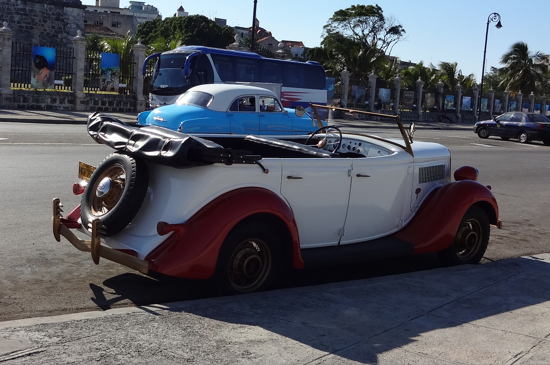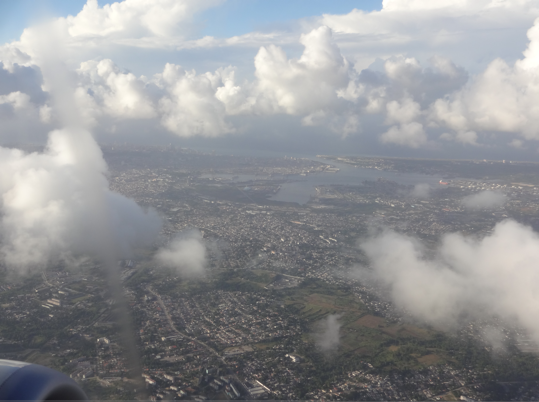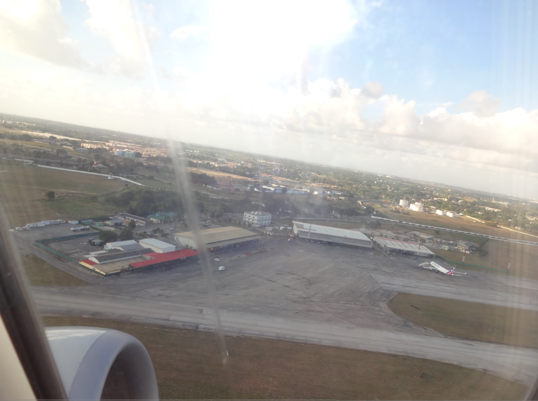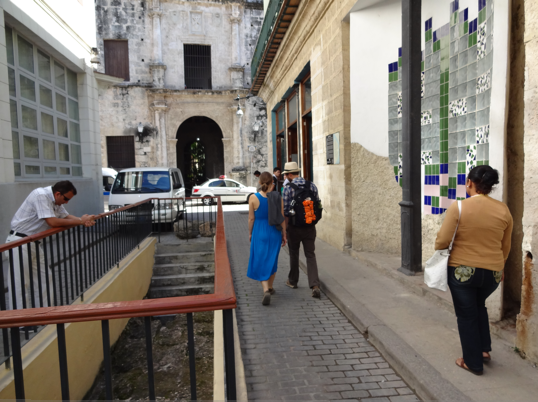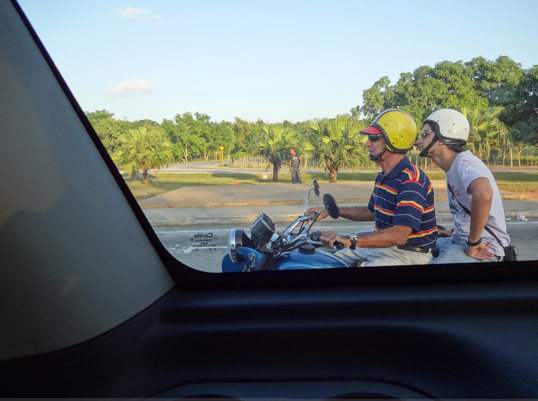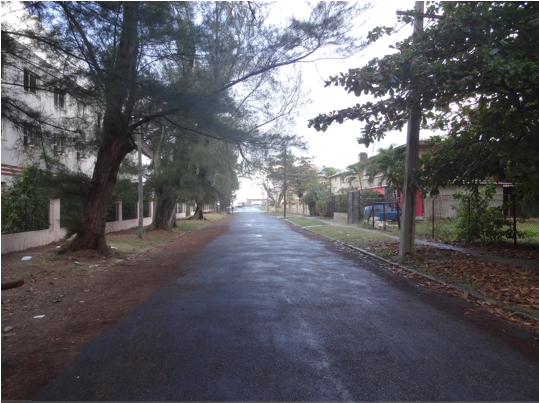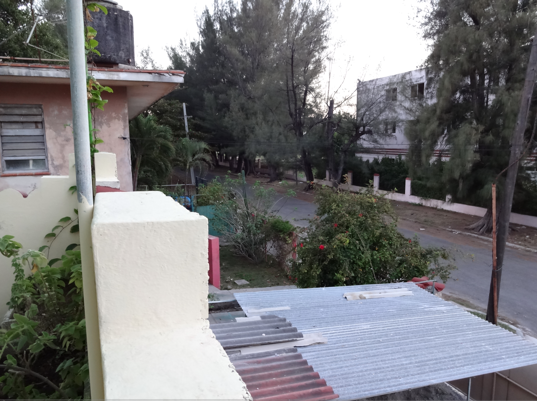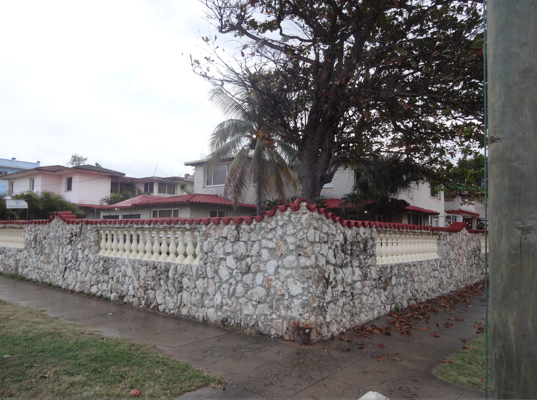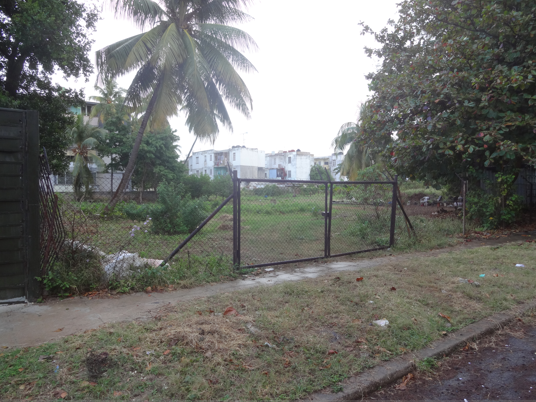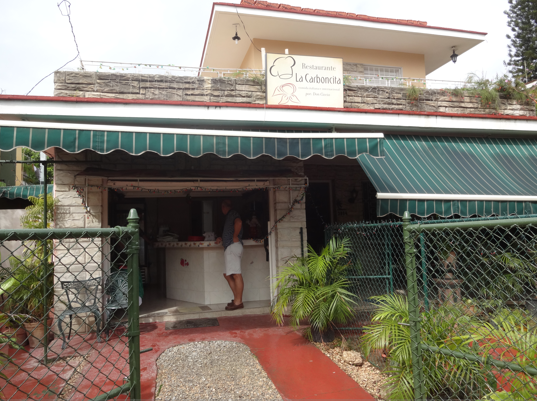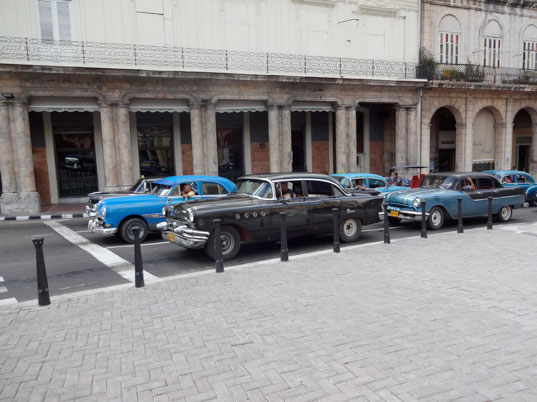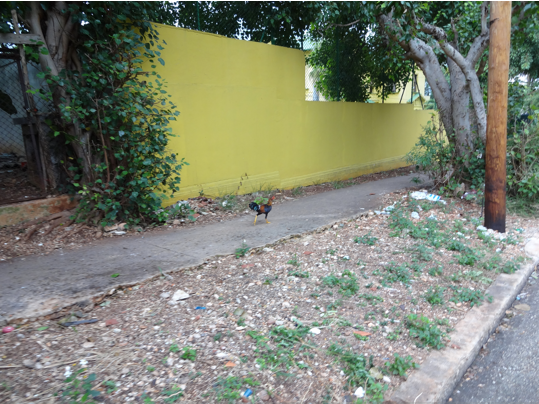Today we finally depart Minneapolis, carrying along with our luggage, a jumbo-sized checked bag stuffed with US packaged, FDA approved baby food for our Havana friends, something impossible to get there. We were warned to arrive very early for the Miami/Havana charter flight and informed that it might depart early ... or late, one can't be certain, but if you call to say you'll be arriving late, they might hold the plane for you ... or not. Before departing the US, we are already being introduced to third-world logistics. So with time constraints and associated bureaucratic complications we overnight in Miami rather than attempt the same-day connection.
Sunday 2012-1125
Except for Adele, we're all a bit anxious returning to Miami's airport. At the ABC Charter desk (owned by American Airlines), the inevitable red tape begins to roll out. Checking in is inefficient and schizophrenic as everyone must check-in themselves in one line and their bags in another. A profusion of Cuban-Americans are bringing airport carts overflowing with many huge bags and boxes - scarce and unavailable products for their families in Cuba. Most of the bags are cloaked in yellow/green anti-theft plastic wrap. The strictly enforced TSA rule against leaving your baggage unattended isn't even considered a suggestion here as solo travelers in the bag-check line solicit the nearest breathing soul to advance their bags while they head off to the ticketing line to clear their passports, visas, and get boarding passes. There is a convoluted structure to the baggage policy resulting in our paying an extra $100, probably unnecessarily. We're still in USA but it feels as if we've already crossed over to the third world. After reviewing the process, our layover decision was the right choice.
While we waited at the boarding gate, a hispanic man on our flight senses our approachability and perhaps anxiety. He's on his way to visit his mother-in-law in Cuba - says he has flown there about 20 times. With his newly captive audience, he spends about 20 minutes describing his personal Cuba-perspective and tells us a few general things to be careful of. He warns not to drink the water, and even suggests that we may want to consider boiling the bottled water - hmm. But he also says we will love Cuba because of the wonderful people and the beauty, and we "will want to return - everyone does". On the Miami-Havana flight Janet and I were seated in the only row without a window on our side of the plane so we couldn't watch the Cuban shoreline approaching. I had complained to the airline a week earlier that it seemed absurd to pay more to fly the mere 100 miles from Miami to Havana than 1500 from Minneapolis to Miami - this may be their way of responding to my grievance.
We ride the brief charter flight with many Cuban Americans visiting relatives and friends, and a handful of non-Cuban Americans. There is a loud applause throughout the cabin as we touch down on Cuban soil. Flying here from anywhere but USA, passengers arrive at the big (we're told modern) Jose Marti International Airport. But instead of a jetway, we walked down the stairway onto the sunny warm tarmac of the tiny but very busy Havana charter terminal. It feels similar to other third-world airports we've been to. We flounder through the airport confusion, fill out declarations, pose for photos for Fidel and Raul, have our papers and faces carefully scrutinized, and so on. The immigration staff seem careful not to smile, although they do welcome you once you've been approved.
After everyone else was cleared and passed through, I was detained alone while half a dozen telephone calls were made, then eventually ushered back into the entry area adjacent to the tarmac and held there for a while. During my detainment, in addition to two guards, there were two non-uniformed men, all speaking rapidly to each other and apparently discussing my entry papers - I could not make sense of their conversation. Eventually I was escorted back to the immigration booth, my visa was stamped, and I was welcomed to Cuba, then just before I reached the final customs clearing desk, a man approached me and began speaking to me very rapidly in Spanish. After hearing my response "I speak English", he apologized and said, "sorry, I mistook you for someone else". This same man was both onboard our flight, and present speaking with the guards during part of my detainment. The ordeal was only an annoyance, but was completely confusing because of my inability to understand the interchange that took place. "Cuban" Spanish, according to our native Spanish-speaking friend, is a "mumbled" dialect that is often near-impossible to understand even for him.
Once outside the airport, our friend here working for the US State Department met us among the mass of people waiting for our flight's arrival. He says that diplomatic officials from every country except those from USA are allowed to enter the airport. Our friend said that nearly every arriving group from the USA seems to have at least one unnerving airport story to tell - my turn. The parking lot is full of taxis, half of them 1950s American classic cars. We take a 30 minute ride in the State Dept. SUV traveling rapidly through south Havana toward our new home. Aside from the expected old classic American cars and the crazy fast Cuban drivers, the first thing we all notice on arrival here is the air pollution.
It appears there not much concern about motor vehicle pollution, and with a predominance of very old cars from USA and the Soviet Union, and lack of available repair parts, regulations wouldn't likely make a difference anyway. The old engines burn fuel very inefficiently and many worn-out engines also burn lots of motor oil. We often see a big cloud of black or blue smoke puffing out the back of many of the old cars when they accelerate. Even driving in a newer SUV with the windows shut and air conditioning on, the air inside the car smells of exhaust, in some areas much worse than others. One saving grace I suppose is that although Havana is quite a large city, only a limited number of people can afford or are allowed to own cars - I surmise it could be far worse. This situation also results in a very fortuitous lack of gridlock during the rush hours. We immediately notice also the level of decay in buildings, stadiums, roads, sidewalks, and generally everywhere we look.
En route we are apprised of various things Cuban. Item number one, "don't drink the tap water", because Havana residents' water supply is provided only every other day for all dwellings here, forcing everyone who wants water on the off days to stock up, typically by using a cistern on the roof where bacteria forms. But the bottled water is okay, a relief. We also must be careful about where we point our cameras - no photos of police, military personnel, and associated buildings, airports, official buildings, embassies, official vehicles, and so on. Nearing our destination the SEPSA is brought to our attention, police stationed in booths on the street corners at embassies. SEPSA is an acronym for "La Empresa de Servicios Especializados de Proteccion, S.A." or "Specialized Protection Service". They are state police by another name and are charged with "protecting" the diplomatic missions in Cuba.
Our house, officially called Casa de Anna e Ismael, is at Calle 32 y Avenida Primero (32nd street and 1st avenue). It's on a corner across the street from the ocean in the district of Miramar. It is a "casa particular", which in Cuba, is a private home with one or more rented rooms, something only recently allowed by the agonizingly slow relaxation of restrictions by the Cuban government. On arrival, our host checks us in and requests our passports and papers, apparently to confirm our location with the central government. Her attempts to call in the information are met with logistical difficulties and she wants to keep them until they can reach the proper officials charged with the task of keeping track of us. I hesitantly yield with the caveat that we will need them first thing in the morning because we plan to visit the embassy - it's rather disconcerting surrendering our passports here, especially to someone we neither know nor necessarily trust. I would think that a US passport is worth quite a bit here in the black market.
Our yard, walled in and with locked gates, is covered in a very dense unfamiliar type of grass. The house, built in the 1950s and attractive from the outside, was as nice as could be expected considering the general condition of Cuba. Beds were all quite hard with thin mattresses. Some outlets worked, some didn't, one lamp had a useless broken plug. The kitchen stove, parked in the far corner on top of the counter, had a pair of small gas burners similar to a camp stove, no oven or microwave. Shower drains have no traps so they smell like sewer gas - we cover them when not in use. This is a nice large house with typical conditions, owing to the lack of supplies and materials available here. Although Miramar is considered to be an elegant district of Havana, residents of USA would not initially reach that conclusion without first comparing it to other areas in the city.
In spite of these shortcomings, we all are very pleased to be renting from a cuban family rather than a state-run hotel. Initially we planned on spending our first few days in Cuba at a Casa in the town of Guanabo, one of the playas del este (beaches of the east) not far from Havana. But our friend told us that we would be rather remote - a thirty minute taxi ride just to get back to the city. The east end of Guanabo, where during our research we found the most attractive casas to rent right on the beach, would also be at the absolute extent of our travel limitations as American diplomatic guests. There is, we are told, a sign placed there warning us not to pass. In the end we settled on spending the entire week at the casa in Miramar - it turned out to be a satisfactory choice in our minds although we never actually saw our prospective beach casas.
A block away from our casa, we toured the home provided to our friends as US State Department diplomats. It was surrounded by a very tall, semi-opaque security fence with a locked gate leading to the parking area and entry, and a very friendly guard dog named Manila. Our friend says he's sure the house is bugged. We are a bit conscious of what we say even though we have no secrets, except perhaps my desire to photograph things I shouldn't. He laughs and says that at some point the listener-spies will get tired of hearing crying babies and discussions about who will change the poopy diapers.
When they moved into this house they hired a cuban woman as a housekeeper and to help with the kids. They decided to increase her salary because she did a good job and the Cuban wages were truly impoverishing - it's hard to believe anyone could live on such a wage. After some time she was arrested for accepting a wage scale above the standard allowed, and told never to speak to our friends again. From that point on any extra payment to others had to be done clandestinely.
We meet their 11 month-old twins, and hear the story of how derelict the house and yard was when they took it over. It is now a very nice functional home with beautiful architecture and high ceilings. We can't use US issued credit cards or US currency so we bought 700 CUCs (cuban convertible currency of equal value to the US dollar) from our friend, and are ready to go, so off we venture into the Havana wilderness. After struggling with "no Ingles" of our lady of the Casa, I got directions in Spanish and walked to the nearest market, Copa Mercado, for some provisions including the essential bottle of Cuban rum. The streets here are organized so that every other street number is skipped, so the expected 12 block walk concluded after only 6. The parking area of the mercado was bustling with activity, including several men approaching, offering generous compliments and joyfully welcoming this visitor from America before offering various services. They will happily show you to a taxi, or show you to someone who can show you to a taxi for a small donation. Want to buy a cigar?
The mercado was marginally stocked as all Cuban markets are. There was no produce whatsoever (produce is available at scattered agricultural markets), a few meat products, much of it frozen, about 3 types of cheese, a very limited selection of bags of tiny (barely bigger than breadsticks) loaves of refrigerated bread, a surprisingly reasonable amount of canned goods including from the USA, Nash Finch's "Our Family" brand. How did that get here - through Mexico maybe? There was no pre-popped popcorn or chips, a few crackers and one strange looking but very abundant variety of Cuban cheese-puffs which we saw everywhere but never bought. Some Cuban colas and soft drinks, two brands of Cuban beer and a few major international brands like Corona and Heineken were on the shelves along with a limited selection of wines. There was however, an ample supply of numerous Cuban rums and a few others from around the Caribbean. On the far side of the mercado there was a section selling everything from table-size to major appliances. And one other thing - hundreds of bottles of water in every size imaginable, in multi-unit packages. In the store there are at least three distinct areas to pay for your purchases, and you are supposed to know which line to get into to pay for the products you are buying. For the items I purchased, I was supposed to go through three lines (I learned the next day) but only visited two, unknowingly paying for yogurt in the wrong line. Perhaps it's just a typical bureaucratic obstacle for the shoppers and the clerk just didn't want to deal with my ignorance, but she checked me out without a fuss. Perhaps she pocketed the cash for the yogurt for her starving family. The nearby gas station reveals one tactic many Cubans use to keep their ancient American cars running - I see drivers filling multi-gallon plastic vessels in their trunks in lieu of their rusted out, leaking gas tanks.
After dark we walked several blocks to a restaurant for dinner. On the way we saw quite a few people out walking as well as one man sitting on a corner with his three dogs and a couple of others lingering and discussing something nearby. In other big cities, this situation would immediately set off a personal security alert, but not so here. We never feared walking even long after dark, but Havana is not exactly the city of lights - many of the streets are poorly lit if at all. Nevertheless a solo woman can walk outside safely here at night, and we saw frequent examples of it, at least in our area. But like the rest of Cuba, the unlit sidewalks are falling apart - we saw a few holes deep enough to devour a small child. So a flashlight is an essential item to pack. And because batteries are extremely scarce, it is best to bring either a rechargeable or better yet, one of those crank type generator flashlights.
We entered the tiny paladar Carboncita Restaurant. In the same fashion as casas particulares, paladares are small privately run restaurants, usually in residences, a result of the new private business relaxations. They serve as a counterpart to the bigger state-run restaurants found in many places favored by tourists here. Carboncita is obviously a restaurant in a house. Passing through the gates, the walk is actually a short driveway which goes into a garage, however the garage is converted into a stand-up bar. Carboncita's seating is all outside, under various canopy-covers next to the house. Upon arrival little Adele was famished and begging for food. Fortunately for her and us, it is apparently customary for waiters here to take orders and bring food immediately for very young children before serving everyone else - smart thinking. Havana Club Ron (Rum) Anejo Especial was provided "por la casa" (on the house). Here in Cuba all the food is organic - they either can't afford, or can't obtain fertilizers and pesticides. Meat is quite prevalent on most menus. The food was good at very fair prices.
